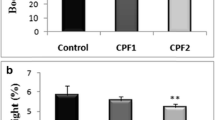Abstract
Hematological, biochemical and histopathological responses of subchronic exposure to aniline hydrochloride (AH) have been investigated in rats. Male Sprague-Dawley rats were given 600 ppm of AH in drinking water while the control rats received tap water only. Five rats from each group were sacrificed at 30, 60, and 90 days of treatment. Organ-to-body weight ratio for spleen in the AH-treated rats was 56, 61, and 53% higher than controls at days 30, 60, and 90, respectively. Liver showed a biphasic pattern for this ratio, a decrease at 30 days and then an increase at 60 days. Among other organs, testes showed a significant decrease in this ratio at 60 days. Hematological analysis showed 65% increase in WBC counts at 30 days in the AH-treated rats, whereas, no changes were recorded at later time points. Erythrocyte counts in the AH-treated rats showed very significant decreases at all the time points, whereas, hemoglobin and hematocrit decreased at 30 and 90 days of treatment. Mean corpuscular volume and mean corpuscular hemoglobin increased in the AH-treated rats at 60 and 90 days of treatment. Methemoglobin content showed significant increases of 89, 59 and 45% at days 30, 60, and 90, respectively. Among serum immunoglobulins, IgA in the AH-treated groups showed 24 and 51 % increases at days 60 and 90, respectively. Analysis of splenic lymphocyte subpopulation showed a decrease in the T-helper (CD4+/CD8−) sub-set at 90 days whereas, other subpopulations were not affected. Aniline hydroxylase activity in the liver microsomes of the AH-treated rats was significantly higher at 60 days of treatment. At all times, spleen demonstrated striking histopathological changes including marked red pulp expansion due to increased sinusoidal cells, fibroblasts, and markedly increased light brown pigment of heme origin. Focal pericapsular fibrosis was found at all times, with no evidence of neoplasia. These histological changes were greatly accentuated with the progression of exposure. Our data, apart from indicating toxicity to the hemopoietic system, show a good interrelationship between damage to erythrocytes and splenic lesions associated with aniline exposure.
Similar content being viewed by others
References
Beard RR, Noe JT (1981) Aromatic nitro and amino compounds. In: Clayton GD, Clayton, FE (eds) Patty's Industrial Hygiene and Toxicology. John Wiley, NY, pp 2A:2413-2489
Betke K, Steim H, Tonz O (1962) A family with congenital methemoglobinemia due to reductase deficiency. German Med Mon 7:217–219
Beutler E (1985) Chemical toxicity of the erythrocyte: In: Iron RD (ed) Toxicology of the Blood and Bone Marrow. Raven Press, NY, pp 39–49
Bus JS, Popp JA (1987) Perspectives on the mechanism of action of the splenic toxicity of aniline and structurally-related compounds. Fd Chem Toxicol 25:619–626
deDuve C, Pressman BC, Giannetto R, Wattiauz R, Applemans F (1955) Tissue fractionation studies: intracellular distribution patterns by enzymes in rat liver tissue. Biochem J 60:604–617
Chem Eng News (1992) 70:32–75
Goodman DG, Ward JM, Reichardt WD (1984) Splenic fibrosis and sarcomas in F344 rats fed diets containing aniline hydrochloride,p-chloroaniline, azobenzene,O-toluidine hydrochloride, 4,4′-sulfonyldianiline, or D&C Red No. 9. J Natl Cancer Inst 73:265–273
Gralla EJ, Bus JS, Reno F, Cushman JR, Ulland BN (1979) Studies of aniline HCl in rats. Toxicol Appl Pharmacol 48:A97
Halliwell B, Gutteridge JMC (1986) Iron and free radical reactions: two aspects of antioxidant protection. Trends Biochem Sci 11:372–375
Harrison JH, Jr, Jollow DJ (1986) Role of aniline metabolites in aniline-induced hemolytic anemia. J Pharmacol Exp Ther 238:1045–1054
, (1987) Contribution of aniline metabolites to anilineinduced methemoglobinemia. Mol Pharmacol 32:423–431
Heys AD, Dormandy TL (1981) Lipid peroxidation in iron-overloaded spleens. Clin Sci 60:295–301
Jenkins FP, Robinson JA, Gellatly JBM, Salmond GWA (1972) The no-effect dose of aniline in human subjects and comparison of aniline toxicity in man and the rat. Fd Cosmet Toxicol 10:671–679
Khan MF, Kaphalia BS, Palafox A, Jerrells TR, Ansari GAS (1991) Heated linoleic acid anilide: toxicity and relevance to toxic oil syndrome. Toxicology 68:143–155
Kim YC, Carlson GP (1986) The effect of an unusual workshift on chemical toxicity. 11. Studies on the exposure of rats to aniline. Fundam Appl Toxicol 7:144–152
Ko I-Y, Park SS, Song BJ, Patten C, Tan Y, Hah YC, Yang CS, Gelboin HV (1987) Monoclonal antibodies to ethanol-induced rat liver cytochrome P-450 that metabolizes anilne and nitrosamine. Cancer Res 47:3101–3109
Miller DM, Spear NH, Aust SD (1992) Effects of desferrioxamine on iron-catalyzed lipid peroxidation. Arch Biochem Biophys 295:240–246
Weinberger MA, Albert RH, Montgomery SB (1985) Splenotoxicity associated with splenic sarcomas in rats fed high doses of D&C Red No. 9 or aniline hydrochloride. J Natl Cancer Inst 75:681–690
Weir MP, Gibson JF, Peters TJ (1984) Hemosiderin and tissue damage. Cell Biochem Function 2:186–194
Wisniewska-Knypl JM, Jabolnska JK, Piotrowski JK (1975) Effect of repeated exposure to aniline, nitrobenzene, and benzene on liver microsomal metabolism in the rat. Br J Ind Med 32:42–48
Wroblewski F, LaDue JS (1955) Lactic dehydrogenase activity in blood. Proc Soc Exp Biol Med 90:210–213
Author information
Authors and Affiliations
Rights and permissions
About this article
Cite this article
Khan Firoze, M., Kaphalia, B.S., Boor, P.J. et al. Subchronic toxicity of aniline hydrochloride in rats. Arch. Environ. Contam. Toxicol. 24, 368–374 (1993). https://doi.org/10.1007/BF01128736
Received:
Revised:
Issue Date:
DOI: https://doi.org/10.1007/BF01128736




